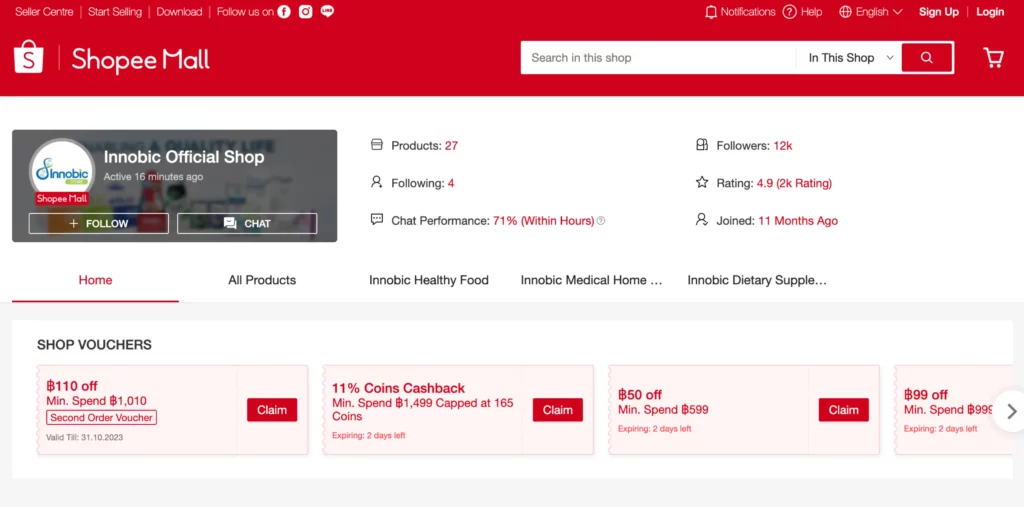
In the ever-evolving digital landscape, establishing an online presence goes beyond just having an eCommerce website. Today, the battlefield is intensely competitive, particularly in thriving markets like Thailand, making SEO (search engine optimization) marketing not just beneficial but necessary for survival. This comprehensive guide is crafted to navigate you through the intricacies of SEO-friendly eCommerce website design that not only ranks high on search engines but also resonates with the user’s needs and preferences. Whether you’re restructuring your existing online store or building one from scratch, these insights will equip you to make informed decisions that could dictate the success of your online venture.
Why SEO Matters for eCommerce Websites

The benefits of SEO for ecommerce stems from the intensely competitive nature of the digital marketplace. Here’s why an SEO-friendly website is crucial:
- Visibility and Ranking: Most online shopping experiences begin with a search engine query. An SEO optimization website increases your chances of appearing at the top of these search results, driving more organic traffic to your site.
- Customer Trust: Sites that rank well on search engines bolster credibility among consumers. A top position is often associated with industry leadership and trustworthiness.
- User Experience: SEO in a website isn’t just about pleasing search algorithms; it’s intrinsically linked to user experience. From fast loading speeds to intuitive navigation, these critical factors keep customers on your site and encourage them to return.
- Cost-Effectiveness: Compared to paid advertising, SEO is an extremely cost-effective marketing strategy. It attracts a targeted audience actively seeking your products or services, resulting in a higher ROI.
- Sustainable Growth: While paid advertising delivers instant traffic, the moment you stop paying, the traffic stops. In contrast, SEO is a long-term strategy. It helps build your brand’s presence online steadily and sustains it as long as you continue to nurture it.
Decoding the Art of SEO for eCommerce Websites

Creating an eCommerce SEO marketing requires an amalgamation of various strategies. It’s not just about keyword insertion or link building; it’s about designing a user-focused experience that resonates with search engine algorithms. This synergy involves understanding and implementing advanced SEO tactics, enhancing website infrastructure, and consistently adapting to SEO trends and upda
Strengthening the Core with Technical SEO

Technical SEO is the bedrock of your eCommerce site’s visibility. It involves non-content elements that make your website appealing to search engines. Here’s how to solidify this foundation:
- Site Architecture: A well-organized site architecture helps search engines decipher your site and enhances user experience. Implement effective crawlable link structures and organize products into logical categories for easier navigation. Also, employ breadcrumb navigation for increased user convenience.
- URL Structure: URLs are not just for your visitors; they communicate with search engines. A descriptive, keyword-conscious URL structure is pivotal. Avoid generic terms, opting for strings of text that give insight into the content of the page.
- SSL Certificate: Cybersecurity is a priority for online shoppers. An SSL certificate encrypts sensitive information, an essential aspect that search engines are increasingly prioritizing. Show that you value your customers’ security, and watch your search rankings improve.
- Page Speed: Slow-loading pages lead to higher bounce rates. Invest in reliable hosting, compress your files, especially images and videos, and utilize website caching to improve load speed. Regularly check your site’s speed using tools like Google PageSpeed Insights.
Importance of a Solid Internal Linking Structure
A robust internal linking strategy is paramount as it dictates the flow of page authority throughout your website, which can significantly impact your SEO website rankings. It helps search engines understand the relationship between different pages and posts, signaling which content is most valuable. More importantly, a thoughtful internal linking structure enhances user navigation, creating a more cohesive browsing experience that encourages longer site visits and, potentially, more conversions.
Implementing Effective Redirects
Handling redirects is an essential skill in technical SEO, crucial when you’re discontinuing a product, moving content, or merging pages. Implement 301 redirects to retain about 90-99% of the ranking power of the original page, ensuring search engines and users are directed to the appropriate page.
Navigating the Shift to Mobile

The mobile-first indexing approach of major search engines underscores the importance of mobile optimization. A mobile-friendly site influences not just rankings but also user acquisition and retention.
- Responsive Design: A site that displays efficiently on various devices—from smartphones to tablets—significantly impacts user interaction and engagement. CSS media queries, flexible grids, and responsive images ensure your website adjusts to any screen size.
- Touchscreen Readiness: As finger-scrolling replaces mouse-hovering, designing clickable elements, sliders, and other interactive features for touch is essential. Regularly test these features to avoid usability frustrations.
- Speed Enhancement: Mobile users demand speed, making accelerated mobile pages (AMP) a necessity. AMPs strip down HTML and streamline content delivery, drastically improving mobile loading times and, consequently, user satisfaction.
Prioritizing Local SEO for Mobile Users
Integrating local SEO strategies for ecommerce website, like creating a Google My Business listing and including local keywords, can capture this traffic. Ensure your site features in the ‘local pack’ of search results, significantly increasing visibility among local mobile users.
The Convergence of Voice Search and Mobile
With the rising use of digital assistants, optimizing for voice search is becoming imperative. This trend is especially significant for mobile users who rely on voice commands. Incorporate a more natural language into your content, consider user intent, and aim for featured snippets to address voice search queries effectively.
Enhancing User Experience for SEO Leverage

Google’s algorithm updates underscore the influence of user experience (UX) on SEO in a website. A site designed with the user in mind will naturally align with SEO best practices.
- Easy Navigation: An eCommerce site should guide visitors seamlessly through product ranges and purchase funnels. Invest in high-quality UX website design to ensure intuitive site navigation, decreasing bounce rates, and encouraging customer exploration.
- Rich Snippets: Elevate your search engine results by adopting Schema markup. This advanced SEO tactic improves how your results appear, potentially boosting click-through rates and competitive advantage.
- Checkout Simplicity: A complicated checkout process is a conversion killer. Ensure your process is straightforward, with clear instructions and simple forms. Transparency in costs and security measures at checkout can also reduce cart abandonment rates.
Accessibility and Inclusive Design
SEO extends beyond traditional practices, tying into the broader aspects of website accessibility. Ensuring that your site is accessible to people with disabilities not only broadens your customer base but also improves overall usability, a key factor in search ranking algorithms. Techniques include using ALT text for images, ensuring site compatibility with screen readers, and providing transcripts for audio and video content.
The Role of Behavioral Metrics in UX
Search engines are increasingly considering user behavior metrics as ranking signals. High click-through rates (CTR), low bounce rates, and prolonged on-page times are indicative of a site that provides value to its users. Employ compelling CTAs, engaging content, and interactive site features to improve these metrics.
SEO Content Strategy: The Indispensable Pillar

Quality content differentiates your brand, establishes authority, and captures organic traffic. It’s not just what communicates with your customers; it’s what communicates with the search engines on your behalf.
- Keyword Research: Utilize tools like Google Keyword Planner or Ahrefs for insights into industry-specific terms and phrases. Understand user intent, and align your products with the needs and language of your customers.
- Unique Product Descriptions: Create custom, keyword-rich descriptions for your products. Duplicate content dilutes your SEO potency. Original, compelling narratives enhance search engine visibility and can sway purchasing decisions.
- Leverage Multimedia: Engaging content isn’t limited to text. Videos, quality imagery, and interactive media can reduce bounce rates, increase time on site, and enhance the overall shopping experience. They also provide opportunities for backlinking and social sharing.
Blog Integration for Continuous Content Creation
Regularly updated content is a signal of your site’s relevancy to search engines. Integrating a blog section allows for continuous content creation, providing fresh material for search engines to index and offering valuable information to keep users engaged. Discuss trends, offer insights, and use this platform for long-form content that incorporates your strategic keywords.
Harnessing User-Generated Content
User-generated content (UGC), like customer reviews and testimonials, can be a goldmine for SEO. UGC keeps your content fresh, provides authentic proof of quality, and encourages community interaction. It often includes keywords and phrases used by real users, potentially improving your search rankings based on genuine user intent.
Mastering the Intricacies of Link Building

A website’s authority heavily relies on its link profile. Mastering both internal and external link building is a strategic component in commanding search engine respect and recognition.
- Internal Linking: Use internal links wisely to establish information hierarchy, distribute page authority, and guide customers toward high-converting pages. This strategic network within your site helps search engines understand your content structure, aiding in more effective indexing.
- Backlink Strategy: Acquiring links from reputable, authoritative sites in your industry is a vote of confidence in your content. Beyond just guest posting, creative collaborations, testimonials, and quality content can naturally attract backlinks.
Nurturing Relationships with Influencers and Bloggers
Link building isn’t just about numbers; it’s about the quality and relevance of those links. Collaborating with influencers and bloggers can result in high-quality backlinks from diverse, authoritative domains. More importantly, these relationships can provide access to a broader audience and create opportunities for co-marketing campaigns or guest blogging.
The Growing Importance of E-A-T in Link Building
Google’s emphasis on Expertise, Authoritativeness, and Trustworthiness (E-A-T) necessitates a link-building strategy centered around these principles. Garner links from reputable sources, produce high-quality content, and ensure your site is a reliable source of information in your niche. These practices build your site’s credibility, making it more attractive for high-authority domains to link to your content.
The Best SEO eCommerce Platforms in Thailand
Understanding the theory and strategy behind SEO is crucial, but seeing it in action can provide valuable real-world context. In Thailand, where the digital marketplace thrives with an array of diverse online businesses, best ecommerce websites in Thailand have distinguished themselves by masterfully employing SEO best practices. Let’s delve into these success stories and glean insights from their effective strategies.
Thompson Golf Management (TGM): SEO in Niche Markets

Thompson Golf Management (TGM) makes its mark by optimizing for a niche audience. Operating in the intersection of sports and online retail, TGM recognizes the importance of a tailored SEO strategy. Their focus on specific keywords relevant to the golfing community demonstrates an understanding of targeted SEO. By optimizing content that resonates with golf enthusiasts and ensuring their platform is navigable and fast, TGM creates an online environment that appeals directly to their market segment. TGM’s success is evidence of how well-executed, specialized SEO strategies can propel even the most niche markets into the limelight within the digital shopping realm. TGM’s SEO-friendly website, a testament to this success, was skillfully designed by Asia Media Studio.
Lazada Thailand: A User-Centric Approach to SEO

Lazada Thailand, a pioneering eCommerce player in Thailand, excels in creating a seamless shopping experience. Their secret lies in understanding customer behavior, which reflects in their site architecture, mobile responsiveness, and highly relevant content. They invest significantly in keyword research, ensuring they tap into the precise queries potential customers are using. This customer-centric SEO approach drives massive organic traffic, making them a top-ranking online shopping destination.
Shopee Thailand: Mastering Technical SEO

Competing closely is Shopee Thailand, another dominant presence in Thailand’s online shopping sphere. Shopee’s edge comes from its robust technical SEO. The platform boasts superior page loading speeds, an aspect that not only ranks it high in search engine results but also endears it to shoppers who value fast, uninterrupted online shopping. Additionally, its SSL-secured platform signals trust to both consumers and search engines, creating a secure shopping environment.
JD Central: Link Building for Authoritative Presence

JD Central highlights the power of strategic link building. By fostering partnerships with reputable brands and influencers, they accrue high-quality backlinks that significantly boost their site’s authority. This strategy extends their reach beyond the conventional consumer base, attracting traffic from diverse, high-authority sources. Their success reaffirms the importance of combining solid link-building strategies with other aspects of SEO.
Conclusion
Mastering SEO for your eCommerce platform is a multifaceted journey that demands both technical acumen and an understanding of your audience’s behavior. To design ecommerce websites is an intricate task that blends technical, aesthetic, and content-driven strategies. As you embark on this comprehensive approach, focusing on user experience, site performance, quality content, and authoritative link building, you position your online store for higher search engine rankings and, by extension, greater market visibility. Staying abreast of evolving SEO trends and continuously refining your strategies will cement your eCommerce platform’s success in the dynamic digital marketplace.
Here’s where a collaboration with Asia Media Studio can make all the difference. Renowned for our digital solutions, we have carved a niche in bolstering online presences across various industries. Our expertise in creating visually appealing, SEO optimization, and user-friendly designs ensures that your eCommerce platform is not just a digital storefront but a destination that provides an immersive customer experience. Contact Asia Media Studio today, and let’s craft an unforgettable digital presence for your brand together.




